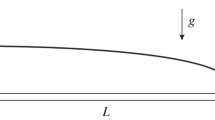Abstract
A slow viscous flow in a plane microchannel with both walls being textured superhydrophobic surfaces is modeled numerically. A striped texture of the superhydrophobic surfaces is formed by infinite rectangular microcavities partially or completely filled with a gas. The microcavities are located periodically and oriented perpendicularly to the flow direction. The cases of symmetric and asymmetric arrangement of the microcavities on the opposite walls are considered. For the solution of the Stokes equations in the domain corresponding to one flow period, the method of boundary integral equations is used. The flow patterns are constructed. A parametric numerical study of the effect of gas bubbles trapped by the superhydrophobic walls on the intensity of effective slip of the fluid and the drag (pressure difference) reduction in the microchannel is performed.
Similar content being viewed by others
References
J.P. Rothstein, “Slip on superhydrophobic surfaces,” Annu. Rev. Fluid Mech. 42, 89–109 (2010).
J. Ou, B. Perot, and J.P. Rothstein, “Laminar drag reduction in microchannels using ultrahydrophobic surface,” Phys. Fluids 16, 4635–4643 (2004).
A. Lafuma and D. Quere, “Superhydrophobic states,” Nature Materials 2, 457–460 (2003).
C. Lee, C.-H. Choi, and C.-J. Kim, “Structured surfaces for a giant liquid slip,” Phys. Rev. Let. 101 (6), 064501 (2008).
M.Z. Bazant and O.I. Vinogradova, “Tensorial hydrodynamic slip,” J. Fluid Mech. 613, 125–134 (2008).
A.I. Ageev and A.N. Osiptsov, “Self-similar regimes of liquid-layer spreading along a superhydrophobic surface,” Fluid Dynamics 49 (3), 330–348 (2014).
J.R. Philip, “Flows satisfying mixed no-slip and no-shear conditions,” J. Appl. Math. Phys. 23, 353–372 (1972).
O.I. Vinogradova and A.V. Belyaev, “Wetting, roughness and flow boundary conditions,” J. Phys.: Condens. Matter. 23, 184104 (2011).
C.J. Teo and B.C. Khoo, “Analysis of stokes flow in microchannels with superhydrophobic surfaces containing periodic array of micro-grooves,” Microfluid. Nanofluid. 7, 353–382 (2009).
C. Schonecker and S. Hardt, “Longitudinal and transverse flow over a cavity containing a second immiscible fluid,” J. Fluid Mech. 717, 376–394 (2013).
A. Steinberger, C. Cottin-Bizonne, P. Kleimann, and E. Charlaix, “High friction on a bubble mattress,” Nature Material 6, 665–668 (2007).
G. Bolognesi, C. Cottin-Bizonne, and C. Pirat, “Evidence of slippage breakdown for a superhydrophobic microchannel,” Phys. Fluids 26, 082004 (2014).
Y. Xiang, Y. Xue, P. Lv, D. Li, and H. Duan, “Influence of fluid flow on the stability and wetting transition of submerged superhydrophobic surfaces,” Soft Matter 12 (18), 4241–4246 (2016).
C. Lee, C.-H. Choi, and C.-J. Kim, “Superhydrophobic drag reduction in laminar flows: a critical review,” Experim. in Fluids, 57 (12), 176 (2016).
A.M J. Davis and E. Lauga, “Geometric transition in friction for flow over a bubble mattress,” Phys. Fluids 21, 011701 (2009).
D. Crowdy, “Slip length for longitudinal shear flow over a dilute periodic mattress of protruding bubbles,” Phys. Fluids 22, 121703 (2010).
C.J. Teo and B.C. Khoo, “Effects of interface curvature on poiseuille flow through microchannels and micro-tubes containing superhydrophobic surfaces with transverse grooves and ribs,” Microfluid. Nanofluid. 17, 891–905 (2014).
A.I. Ageev and A.N. Osiptsov, “Stokes flow over a cavity on a superhydrophobic surface containing a gas bubble,” Fluid Dynamics 50 (6), 748–758 (2015).
A.I. Ageev, I.V. Golubkina, and A.N. Osiptsov, “Application of boundary element method to stokes flows over a striped superhydrophobic surface with trapped gas bubbles,” Phys. Fluids 30, 012102 (2018).
C. Pozrikidis, Boundary Integral and Singularity Methods for Linearized Viscous Flow (Cambridge Univerity Press, New York, 1992).
C.S. Nishad, A. Chandra, and G.P.R. Sekhar, “Flows in slip-patterned micro-channels using boundary element methods,” Engineering Analysis with Boundary Elements 73, 95–102 (2016).
E. Alinovi and A. Bottaro, “A boundary element method for stokes flows with interfaces,” J. Comput. Physics 356, 261–281 (2018).
V.A. Yakutenok, “Numerical modeling of slow viscous fluid flows with a free surface,” Matemat. Model. 4 (10), 62–70 (1992).
Author information
Authors and Affiliations
Corresponding author
Additional information
Russian Text © The Author(s), 2019, published in Izvestiya RAN. Mekhanika Zhidkosti i Gaza, 2019, No. 2, pp. 59–71.
Rights and permissions
About this article
Cite this article
Ageev, A.I., Osiptsov, A.N. Stokes Flow in a Microchannel with Superhydrophobic Walls. Fluid Dyn 54, 205–217 (2019). https://doi.org/10.1134/S0015462819020010
Received:
Revised:
Accepted:
Published:
Issue Date:
DOI: https://doi.org/10.1134/S0015462819020010



